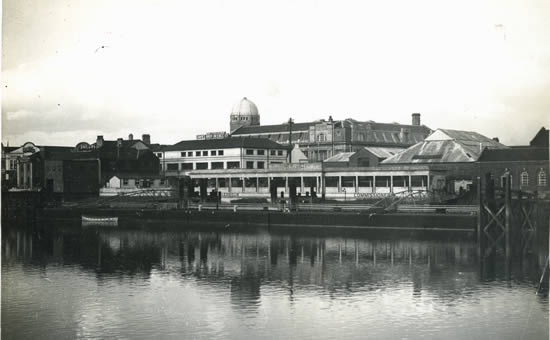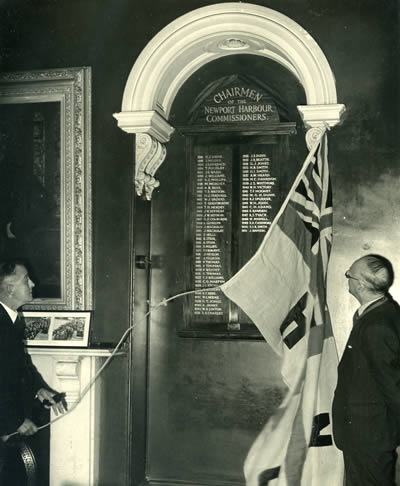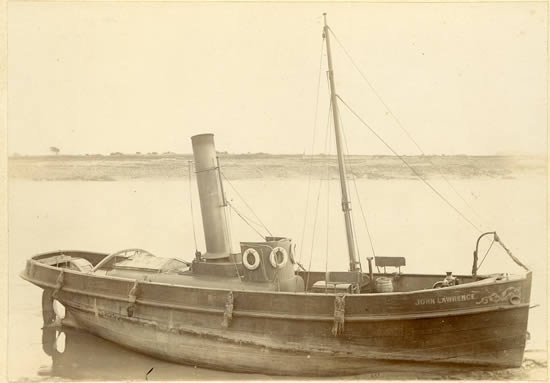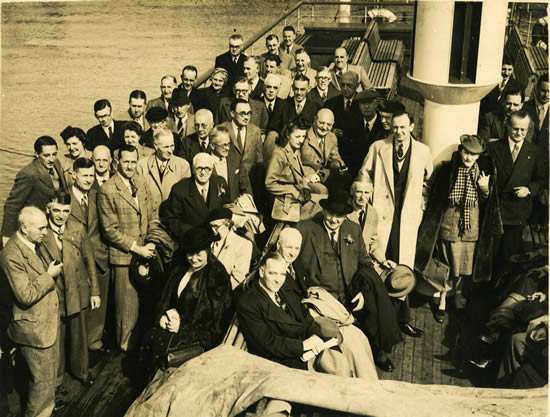Newport Harbour Commissioners
By Jim Dyer
First published in the Western Mail 1987 and revised 2012
© Jim Dyer 2012
When this article was first published Newport Council had plans to construct a barrage across the River Usk following the success of the Cardiff Bay scheme. This however did not come to fruition and much of the capital was consequently spent on improving the river frontage which bears results today.
Also despite a much reduced role due to shipping trade the Harbour Commissioners still perform a useful role in looking after the Bristol Channel from points around Nash running west to Wentloog. Many of the faces and characters in the organisation have changed as they have adapted to these changes. Today the Chairman is Colin Crick who has been in that position for a few years.
Background
Stretching back to 1836 it falls to them to ensure that the safety and navigational interests of shipping are maintained.
They have a veritable wealth of knowledge going back to the days when the river used to be teeming with ships - masted coasters and barques loading and discharging the various cargoes at the many wharves. When the shipbreaker John Cashmore set up business many famous liners and warships were towed upstream to be scrapped. In the 60s chaos was caused when a Great Lakes steamer laden with scrap slipped its moorings threatening the newly built George Street Bridge.
The role of the Commissioners now has broadly changed over the decades as trade shifted from the river to the deep-water docks. They are however an important influence on shipping though little known to many.
Their Job
At this time the Clerk to the Commissioners, Dave Simms, told me they maintain navigation aids of the port and harbour. Their control stretches from Peterstone Church to Goldcliff Point and upstream as far as the tide reaches, Newbridge-On-Usk.
All vessels berthing at the docks or using the river pay dues to the Commissioners for this facility - in 1987/8 these dues produced a revenue of £120,000. They also act as a go-between for other authorities such as Trinity House. For many decades their offices were at Lower Dock Street but now are based in Bridge Street.
Ironically it was partly because of wrangling about fees that the commission came into being.

Newport Harbour Commissioners landing stage 1957.
Early Days
Newport thrived in the throes of the industrial revolution as the transport of coal from the valleys was made easier by the construction of the Monmouthshire and Brecon Canal towards the end of the 18th century. The river was crowded with ships with no controlling body except the mayor of the borough. He had an ancient right to collect 'mastage'. For this he had to regulate traffic, arrange berths and oversee unloading.
The burgesses of the town were exempt from these charges which only applied to ships from other ports.
This brought in about £300 a year and ship-owners objected. Some tried to corner the coal market. One mine owner refusing to sell chartered his own vessel but found his wharf was obstructed. He was forced to pay protection money.
This chaos combined with the owners’ refusal to pay mastage led to a government inquiry into the management of the river in 1833 leading to the Commission in 1836. The construction of the first docks was completed in 1842 (Old Town Dock).
Famous Names
Over the years many famous local names have appeared amongst the commissioners. One of the originals was Sir Charles Morgan of Tredegar House. Many council leaders like the gentleman Aubrey Hames were the Commission’s chairman. Today it is Colin Crick, a senior council employee.

12th March 1952. Unveiling of part chairmen of the board of Newport Harbour Commissioners by Mr GT Jones. South Wales Argus photo.
Councillor, Brynley Williams, chaired a very special dinner in 1986 for 150 years of activity. Another commissioner, William Dowds, a local businessman connected with shipping, presented a set of engraved glassware to the people of the town.
Commission’s Boats
The first vessel, the steam tug John Lawrence, was taken in 1894 and served until 1957 when it was sold for scrap to John Cashmore on the river. The present 'Uskmoor' was built in Bristol under the guidance of the Harbour Master, Captain Kruzins, and his crew of two.

Newport Harbour Commissioners Steam Tug "John Lawrence". Official No. 98880. Length 78ft 9ins Beam 15 ft 4½ins Moulded depth 9ft 5ins Tonnage Gross 63.6 Nett 12.94 HP 200 Built by Mordey Carney % Co. Newport and delivered 14th June 1894. Cost £2794 1s 8d. Withdrawn from classification at Lloyds Dec 1913. 29 April 1957 towed to Cashmores for breaking up.
Annual Inspections
This has now been discontinued as such in the old form. The annual event was well known for the trip across the Bristol Channel to Weston for lunch. Usually the paddle steamer 'Waverley' was employed but problems with the pier there sometimes necessitated docking at Clevdon or Portishead. Many national figures like Gerald Kaufmann MP spoke at the dinners which provided a means for many local businessmen to interact.
These trips were somewhat controversial but were popular causing much competition for tickets.

1947 Harbour Inspection. South Wales Argus photo.
Finale
This short note has given a rough history of Newport Harbour Commissioners and how their role has changed over the years. The present position (2011) is included on their web site but I was unable to look at the budget which is not on the site. Generally they have an advisory and navigational role - the importance of which has heightened since the maritime accident in Milford Haven a few years back.
SOURCES
1. Proceedings of Newport Harbour Commissioners pre 1987.
2. NHC Website.
3. South Wales Argus reports and articles.